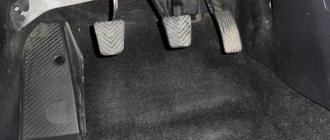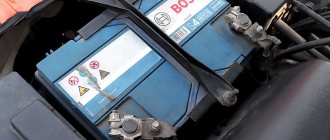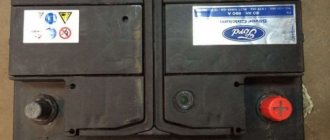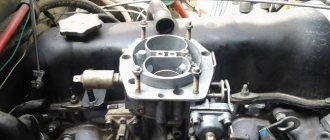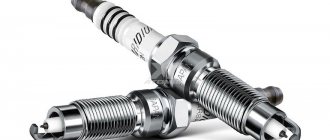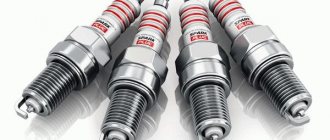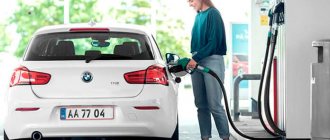Lighting a car: is this procedure harmful to the vehicle?
First you need to find out what is called the process of lighting a car? This is a procedure by which a dead or low (but always serviceable) battery in the recipient’s car is recharged.
What does this mean, let's look at everything in order. First, let's define the notation:
- The donor is a car that is suitable for lighting. It must be not just a vehicle, but one that meets certain criteria, which you will learn about in a separate section of this material.
- A recipient is a vehicle whose engine does not start on its own and therefore requires lighting.
The word "light up" is slang for getting a charge from another car's alternator. It is important to understand here that the lighting procedure does not involve starting the engine from the battery of another car, but recharging a dead battery in order to restore its charge reserve for the subsequent start of the recipient’s engine.
This should be understood, since some drivers perform this procedure by connecting the vehicle to the battery of another car, and immediately attempt to start the engine. It is even more important to know how this process is carried out correctly, on which not only the achievement of a positive result depends, but also the possibility of developing negative consequences is eliminated (the result of such consequences can be seen in the photo).
This is a real photo that was taken after an incorrectly performed car lighting procedure. And based on this photo, you should be interested in thoroughly studying the process of lighting a car, which implies not only strict adherence to the sequence of actions, but also the correct choice of wires, as well as the selection of a donor for a successful procedure.
First, let's delve into the question of whether it is harmful to light a car, and for which vehicle it can be harmful? There are many different opinions on this matter on the Internet, but the truth is one: there is no harm to either the donor or the recipient from the lighting procedure. However, there are some “buts”, if not followed, the process can not only be harmful, but also dangerous. It is these “buts” that we will pay special attention to. So, lighting a car is not recommended in a number of the following cases:
- If the donor's vehicle has a dead battery, which, if lit, will not receive enough charge from the generator, and the next time it is started, it simply will not be able to spin the starter due to insufficient current (charge). If the vehicle of the person lighting the cigarette starts with difficulty, then it is not recommended to use it as a donor.
- If the donor vehicle has a weak generator. We are talking not only about its technical parameters, but about the proper functioning. If the generator has difficulty delivering a charge to recharge the battery, then it is not recommended to use it for lighting a cigarette. This will increase the time of the lighting process, but even then it will not be possible to achieve a positive result.
- If the sequence of the procedure is violated, starting from assembling the circuit and ending with the manipulations to try to start the recipient’s motor.
- If the wires for lighting are incorrectly selected. Important parameters for their selection are the following criteria: the material of manufacture of the conductive elements, the appropriate cross-section of the cores, the quality of the insulation and the length.
- If a car with a lower battery capacity and engine power than the recipient is used as a donor. Remember that diesel engines are more powerful than gasoline engines, so diesel can act as a donor for a gasoline engine. A gasoline engine can be a donor for a diesel engine if the former has high power, for example, if it is an SUV or crossover.
- If there is a discrepancy between the output voltage values, that is, if the donor has a 12V on-board power supply, and the recipient has 24V, or vice versa.
- If there are signs of gas or gasoline leakage in the engine compartment of the recipient's vehicle, which could lead to ignition from a spark.
In other cases, the procedure is not only harmless and safe, but also useful. Indeed, often in this way you can help out a friend, comrade or neighbor who has encountered an unexpected difficulty. Next time you may be in his place, so don’t refuse the request. However, if you are afraid for your vehicle, then tactfully hint that your battery is also too weak, and you may also not start the car engine after help.
This is interesting! Many drivers simply do not want to spend time providing assistance in lighting their car. However, the procedure takes 5-10 minutes if all steps are performed correctly and competently.
How to choose a donor for car lighting
Having smoothly approached the question of the correct choice of donor or car from which the lighting process will be carried out, it should be noted that it is important to pay special attention to this criterion. The donor can be a car whose engine power is higher than that of the recipient. However, it is also important to take into account the battery supply voltage, since on crossovers, SUVs and trucks the on-board voltage can be 24V. Such cars are not suitable as donors if you need to start the engine of a passenger car with a 12V on-board network.
It is strictly contraindicated to try to light a cigarette from a car whose engine power and battery capacity are lower, since nothing will come of it. It is also important to choose a car of the appropriate class as a donor. This means that if you need to perform the procedure for a vehicle of older years, for example, a VAZ-2107 with a carburetor engine, then it is recommended to use a similar car with a carburetor fuel supply system as a donor. If you need to start the engine of a foreign car, then you need to look for a donor also a foreign car, for example, the Lanos engine can be started from a Hyundai or Volkswagen, but it is not recommended to call a friend in a VAZ-2106 or VAZ-2109 for help.
This is interesting! Remember that diesel engines are more powerful and therefore require gasoline vehicles with the same power to run them.
Battery capacity
It is important that the car batteries are of the same capacity. Or the donor car’s battery had a larger capacity than the one you are going to “light”. That is, an SUV can drive a modest subcompact car. But on the contrary - no. A small car's battery simply doesn't have enough power to revive a big car. Although if you connect the wires and wait a little longer, and then try to start the car with a dead battery, then there is a chance.
Why you can't start a car with a pushrod
Many people often wonder why they need to light a car when they can start the engine the traditional way called “from the pusher”. This technique has been and continues to be popular among owners of budget cars with carburetor engines. They are not filled with electronics, so power surges in the on-board network during startup will not be dangerous and are unlikely to cause serious problems.
Another question is when a driver tries to start a foreign car from a pusher: Lanos, BMW or Mazda. This will look, first of all, quite funny, since if you can try to push a Lanos on your own, then pushing a BMW or Mazda of the 3rd and especially the 6th model will be extremely difficult. Even if you decide to take such a desperate step, then you should think about the second disadvantage of this method. After all, there is a high probability that all electronics can simply be damaged due to voltage drops when starting the engine according to the pushrod program.
This is interesting! By the way, the cause of failure of the electronics on fuel-injected cars can be not only the method of starting the engine from the pushrod, but also during prolonged attempts to start the engine with a dead battery. If you cannot start the car the 3rd time due to insufficient battery power, then do not continue the process. If you are in a hurry, then try to light the car, and if there is no rush, then the battery can be recharged or replaced. Avoid starting methods like those shown in the video.
If your car does not have a manual transmission, but an automatic or CVT, then the pushrod method is completely contraindicated. After all, in addition to the fact that you will need to push the car for at least 3-5 minutes to warm up the oil in the gearbox, you also need to reach a speed of 30-50 km/h, which is simply not possible even for a crowd of assistants. An alternative to starting the engine from a pusher in a car with an automatic transmission is the towing method, however, this is not recommended (or only in extreme and exceptional cases), as this will significantly reduce the life of your gearbox.
How to properly “light” a car with a dead battery
There are so many cases when you need to “light up” a car, but the circumstances of the assistance and the sequence of some operations change. Much depends on the type of car - diesel or gasoline, automatic or manual. Experienced drivers have a well-established scheme for how to properly “light” their car from another, which donor is suitable and which is not.
So, the connection of the two batteries has been completed, we checked once again for correctness, so as not to get tangled in the wires, it is customary: red cables always connect the plus, the black cable goes from the minus of the donor to the ground of the recipient.
The most common way to properly “light” a dead car from another working one. You need to start the donor engine for the time necessary to recharge the dead battery. This can be from 5 to 20 minutes. Turn off a working car. Remove the wires and perform a test run. You may need to warm up the car a little more, or light up the car with a dead battery if the starter cranks lazily. As soon as the engine is started, the generator will begin to charge the battery, and after 10-15 minutes you can drive.
Another method is designed for experienced drivers with a conventional manual transmission and a minimum of electronics. The wires are connected. How to properly and quickly let the owner of a car with a new battery “light” it? Run the donor engine for 5-6 minutes. Try to start a faulty car. The startup attempt does not exceed 15 seconds, the interval is a minute. As soon as the engine starts, leave both cars turned on and tied to the donor for 3 minutes. Before disconnecting the wires from the terminals in the onboard line, turn on the resistance to smooth out the voltage surge.
“Lighting up” is an undesirable, emergency and dangerous operation. Is it possible to “light” a car if the donor driver has doubts about the serviceability of the battery? The owner's concerns are justified:
- when the frost outside is below -20 0;
- the class of the idle machine is higher;
- higher capacity battery;
- diesel engine.
How to properly “light” a car from another car, look at the video.
How to properly light a car: detailed instructions with a diagram for heavily discharged batteries
When contraindications to the procedure for lighting a car have been studied, wires of appropriate quality and technical parameters have been selected, and a donor car has been selected, you can begin direct implementation.
The diagram for performing the procedure for lighting a car is shown in the photo below. We use it as a basis when we don’t have time to read the material and need to quickly refresh our memory of the whole process.
Instructions for lighting a car
Now let's move on to a detailed description. To light a car with a completely dead battery (you can check this with a multimeter), perform the following steps in strict adherence to the sequence:
- The first step is to position the cars next to each other. It is better if they stand in a one-to-one or sideways direction.
- At the second stage, you should remove the ignition keys from the locks of both cars and turn off all energy-consuming devices (lights, car radio). If you try to connect to the recipient while the donor engine is running, a power surge may occur at the moment of connection, which will lead to the failure of all electronics and electrical appliances. Do not risk your vehicle or your life, and perform the procedure correctly, and most importantly, safely.
- Next we move on to the connection. The first thing you need to do is take the red wire (positive) and connect its clamps to the positive terminal of the donor battery and similarly to the terminal of the recipient battery.
The sequence of connecting the red wire does not matter, although some sources say the opposite, but in fact, no current will flow when connecting the red wire without the black (negative) cable. - Next is a very important point: now the black wire (negative) is connected, and it is important to follow the sequence when connecting it. Initially, the black wire is connected to the negative terminal of the donor car battery. The second clamp is connected to the recipient car, but not to the minus terminal, but to any exposed area of the engine compartment (preferably away from the fuel system).
Many will now ask the question, why can’t it be connected to the negative terminal of the battery? The reason is that when the clamp is connected and the donor motor starts, a spark occurs at the connection point, which can cause a fire and explosion. The cause of a fire can be not only gasoline or gas vapors, but also battery acid. That is why connect the black wire clamp to the vehicle ground so that the mount is away from the fuel system and battery.
Moreover, the contact must be of high quality, and a metal part with a painted surface cannot act as a mass. In exceptional cases, you can connect the clamp to the negative terminal of the recipient battery, but only in exceptional cases, and only when the launch is carried out in an open area, and not in a garage or closed parking lot. - After this, the donor car is started. At this moment, the battery on the recipient is recharged. The quality of charge of the recipient’s battery depends on the duration of operation of the donor’s motor, but since few people use a tester at this moment to measure voltage, you should let the engine run for at least 5 minutes (given that it is heavily discharged). While idling, you can increase the speed to 2000 rpm, which will increase the battery charging speed.
- After this, you need to turn off the donor engine and remove the key from the ignition.
- Further, many often make the mistake of disconnecting the cigarette lighter wires. There is no need to do this for two reasons: the first - perhaps 5 minutes was not enough to recharge the battery, and you will need to repeat the procedure for starting the engine on the donor again, the second reason - the additional capacity from the donor battery will help start the recipient's engine.
- Without disconnecting the wires, an attempt is made to start the recipient motor. If the engine starts, then leave it running and proceed to removing the wires. Disconnecting the wires is done in the reverse order of connecting. The black wire clamp is disconnected first from the recipient, and the second from the donor. Then the red cable clamps are disconnected.
- At this point, the procedure has been completed successfully, and the recipient’s car with the engine running can continue to move. It is advisable not to turn off the engine and let the generator recharge the battery. However, there are cases when the recipient’s engine does not start after lighting. In this case, it is important to pay attention to the signs during startup. If the starter turns sluggishly, which indicates a small battery power reserve, then you should repeat the lighting procedure, but only keep the engine running for at least 10 minutes. If the starter turns vigorously, but the engine does not catch, then the reason must be sought elsewhere. As they say, the problem is not the battery at all.
Using the instructions described above, you can light a car that has a very discharged battery. The biggest difficulty when carrying out the lighting procedure is following the correct sequence of actions. The instructions and diagram described above allow you not only to find out, but also to remember which wire is thrown in first when you light the car. The lighting process is described in detail below.
How to “light” a car correctly
A modern car has complex electronic components that require stable electrical parameters. Specialists and practitioners have developed an algorithm for how to safely “light” one car from another. The sequence of assembling the circuit and removing the wires when lighting a cigarette from the donor's car is important. During the charging period, a current of 300-400 A passes through the circuit; the created short circuit can cause a lot of trouble.
How to properly “light” your battery from another car? First of all, you need to get good quality connecting wires for lighting. Let them always be in the trunk. Included is a black wire for connecting to minus or ground, red for positive. The wires are massive, their cross-section is at least 16 squares. There are alligator clips on both ends. If you choose thinner cables, you may get burned by intense heat and even fire. In Chinese products, thin wires are often hidden under thick insulation.
When choosing a car for “lighting up”, make sure that it has a working battery of equal or greater capacity, but with the same output voltage. Before “lighting” your battery, check its serviceability. You cannot recharge if the battery is frozen in ice or leaking.
Before “lighting” a car from another car, you need to be sure that the car is fully operational, but the battery is dead. If the music is turned on in the cabin, the lights are on, the windshield wipers and lifts are working, but the engine is not a car. Why? The reason is not the battery.
Signs of a bad battery:
- when you turn the ignition key, straining sounds are heard;
- the indicators on the control panel do not light up or light up dimly;
- Uncharacteristic sounds are heard under the hood.
To “light” a car battery, you need to install it in an open place, with the possibility of access for another car. The car used as a donor must run at XX in order for its battery to be fully charged.
Watch a practical video lesson on how to “light” a battery.
How to light a car: instructions for a dead battery
If the battery on the recipient car is not completely dead (we check with a multimeter), but is slightly discharged (the device shows 8-11V), but it does not have enough power to start the engine, then you can use another method of lighting. This method is called simplified, and differs from the previous one only in that it does not require starting the donor engine to recharge the battery. To do this, perform the following manipulations:
- The wires are connected: first of all, red to the positive terminals of both batteries.
- The second wire is connected to the black wire: first to the minus terminal of the donor, and then to the ground of the car or the terminal of the recipient battery.
- During this time, electrical appliances should not be turned on in these vehicles.
- After connecting the wires, you need to wait 3-5 minutes until the battery is recharged from another battery. There is no need to start the donor engine.
- A test run of the recipient engine is carried out. If it is successfully launched, then the wires are disconnected (the black cable clamp from the recipient is disconnected first).
- If the engine does not start, then you should start the donor engine, and thereby ensure that both batteries are recharged.
- Repeat starting the recipient's engine again, but only after the donor's engine has run for 5 minutes and must be turned off.
At this point, the issue of lighting a car can be considered closed. The video below shows this process in detail.
This is interesting! Today in Russia, the car lighting service is popular, provided by various taxi companies, including Yandex.
There are two ways to light a car
The first way to light a cigarette
It can be used if it is not very cold outside and there is still some charge left in the battery - you can turn on the light in the cabin (but it is dim), and the starter turns, but very weakly. This method is completely safe for the machine from which the cigarette is lit.
You must proceed as follows:
- Turn off the engine of the car. The battery terminals must be removed. Don’t be upset - in a few minutes, nothing will happen to the car without a battery.
- Connect the red wire (+) to the battery terminal, and then the same wire to the battery of the car you want to light.
- Connect the black wire (-) to the removed battery. Next, be careful! You cannot connect the negative wire to the negative terminal of a car standing nearby!!! First, this is not true. The second is dangerous. In an attempt to light a cigarette, the battery may run out of charge and then you will have to light a cigarette. Or, if the battery is in a faulty state, then hydrogen will hover above it, and when it mixes with oxygen, a flammable mixture appears, which is very explosive. A small spark is enough (and it will definitely appear when you connect all the contacts) for the battery to explode. Therefore, the negative wire must be secured to any unpainted metal surface of the car body. And place them correctly - as far as possible from the battery. In most cases, it is better to use “ground” for this - the place where the negative wire from the battery is connected. There is a metal plate there, which is screwed on with a bolt. The bolt is not painted - so connect the negative wire to it. If you have doubts, you can find a convenient place on the cylinder block. But make sure that the wire does not touch any moving parts: belt or fan.
- Wait a little. Without removing the terminals from the car whose battery has “died”, try to start it. If the first attempt was unsuccessful, you need to wait a little longer. Do not try to start the car more than 2-3 times in a row. If this fails, then the problem is most likely not with the battery.
- If the engine starts, do not immediately disconnect the terminals. Let the engine come into operating mode and warm up. The terminals can only be removed after 3-5 minutes of engine operation. This must be done in reverse order. The next point should not be forgotten. In a car, when you disconnect the terminals, voltage drops may occur. Therefore, it is necessary to turn on all permissible energy consumers. Don't worry about your battery running out. If your car's generator is in good condition, then everything will be fine. But it is better to turn off the exterior and interior lighting, otherwise for the same reason it may simply burn out.
Why is it not recommended to light cigarettes with boosters?
The classic method of lighting cars lives on and continues to live. Although it does not allow you to replace a full-fledged charger, it still allows you to achieve results with minimal negative impact not only for the car, but also for the battery. Actually, this method is in demand not only because it allows you to quickly start an engine with a dead battery, but also eliminates the need to purchase expensive devices called boosters.
These are portable battery-powered jump starters and chargers. They allow you to start the engine with a dead battery, and cope with this quite efficiently and quickly. However, they also have some disadvantages, namely:
- Price - the high cost makes the devices inaccessible to most car owners. Drivers who can afford such devices will not use them, if only for the reason that it is easier for them to install a new and expensive battery. Even if this happens (there is a need to light a cigarette), then it is easier for them to call technical assistance, which will replace the old battery. That is why such devices are not very popular.
- Reduced battery life - the high starting current that boosters provide to replenish the charge has a very negative effect on the battery. Of course, if the battery is already outdated, then this does not play a big role, and the most important thing is to start the engine in order to get to work or a car shop where you can buy a new power source for the car. However, there are cases when the battery is only one year old, and it simply ran out overnight due to, for example, leaving the car radio on. In order to restore its integrity without harm to the battery itself, you will need to charge it with a minimum current for 10-12 hours.
Naturally, you should not forget that if you have a starter-charger from the mains, then you can also quickly start the car with its help. To do this, just connect the clamps to the battery terminals, turn on the device and wait five minutes. However, this method is also not advisable for frequent use, since high current harms your battery.
What is “lighting up”?
The operation looks like this: The cars are driven towards each other, and wires stretch from under the hood of one to the other. Cars 30 years ago were predominantly carburetor-powered, did not have complex electronics, and the Volga driver could transfer wires even from a KamAZ and start his car without fear that something would burn out in the car. “Lighting up” really helped them cope with the problems of rapid loss of battery charge, because running to the store for a new battery was useless. Buying it was not as easy as it is now.
However, the design of modern cars has undergone dramatic changes. They have developed many electronic systems that are sensitive to sudden voltage surges. In addition, injection engines have an electronic control unit, which is a computer hidden under the hood and launches various ignition programs depending on operating conditions. These electronics easily fail when drivers make mistakes in “lighting up”. As a result, instead of one immobilized car, both can stand up. If you overdo it, a short circuit and even a fire may occur.
What happens if you mix up the battery terminals? More details
Is it possible to start a car without a battery?
If you own a car, then such a question will definitely not come to your mind. After all, the most dangerous thing about this method is that you expose your car to serious loads, which can ultimately cause the electronics to fail. However, this method is dangerous not only for cars with electronics (injection), but also carburetor ones, since even if it is possible to start the engine (and this is possible, as evidenced by the video below), the generator will produce a current that will not consume the battery in the power of her absence. The absence of a battery will lead to voltage drops, and in the end you may pay with serious consequences. This is why you should not try to start the engine without a battery.
Even if you want to implement this method on your vehicle, you are unlikely to find someone who will agree to help light a car without a battery. This idea has no rationale and is unsafe for implementation.
It is also worth noting that home craftsmen offer a method for lighting a car using a screwdriver battery. This method is also contraindicated if you do not want to damage not only the car, but also the power tool. The current that the starter consumes to crank the crankshaft is quite large, and the screwdriver battery is not capable of replenishing it in principle.
The photo above shows a method of starting a car engine from a screwdriver battery, however, repeating this method is not recommended (and if you do this, it is entirely at your own peril and risk), since there is a high probability of failure of the electronics on the car.
Additional information and myths
Connecting the minus to the engine housing
A common question among car enthusiasts is: is it possible to light a cigarette while the car is running? There is a very definite answer to this - NO! This is strictly not recommended. Let's try to explain why...
The fact is that at the moment the engine starts, switching processes occur, the result of which is a significant current jump. When the engine is turned off, only the battery is involved in the circuit. If the engine is running, then the generator and all other current consumers (including expensive computers and other electronics) are connected to the circuit. And for them, sudden surges in current and voltage are very harmful, as they can damage them.
When “lighting up” the donor car, it is advisable (but not necessary) to remove the negative terminal from the battery. This will ensure complete isolation of the electrical circuits of the two cars from each other.
Remember that you cannot ask the owner of the first car you see for a “light.” Ideally, the capacity of the donor battery should be no less (that is, equal or greater) than the capacity of the recipient battery. Otherwise, there is a risk of complete discharge of the donor, and even its failure. And at the same time, most likely, you will never start your car. In other words, you can “light up” a small car from an SUV, but vice versa, you can’t!
You should also not “light” a battery that is heating up, emits a strong acidic odor, or has leaked electrolyte.
It is not recommended to “light” from old or discharged batteries. Therefore, if your colleague driver refused your request, arguing that his car’s battery is old, then you need to treat this with understanding.
Starter for battery
Today, car dealerships offer devices for emergency starting of batteries, so-called starters. They are an analogue of “power banks” for electronic gadgets. “Lighting” from them is simple and safe.
Another common myth is that you can’t “light” a car with an electronic control unit (ECU). Actually this is not true. If the engines of both cars are turned off, then there is no danger to the electronics. The only thing you should remember, and what we have already mentioned, is that you absolutely cannot “light” a car with the engine running .
Advice on extending battery life or how to eliminate the need to light a cigarette
It is important to understand that if the car needs lighting, then you must purchase a new battery if the procedure is successful. To extend its life, you need to know the following:
- Eliminate the possibility of frequently starting the engine with low mileage.
- You cannot leave the battery discharged for a long time, as this will lead to its complete unusability. If the battery is discharged, you should immediately replenish its charge from a generator or charger.
- Monitor the serviceability of the generator, as insufficient current production leads to a slow decrease in battery life.
- Starting the engine in winter must be completed with sufficient mileage to restore the charge. Try to drive more kilometers in winter, thereby giving you the opportunity to replenish your charge.
- To make engine starting easier in winter, it is recommended to use preheaters.
- Monitor the age of the battery, and it is better to replace products that are more than 5 years old immediately, without waiting for cold weather.
And based on the methods described above, it will not be difficult to light the car not only correctly, but also safely.

